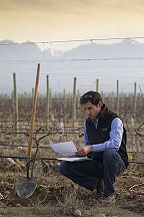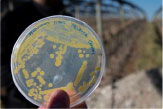|
|
|
|
|
The Catena Institute of Wine is Officially Introduced at South American Wine Summit
Introduction comes as the Institute publishes key research in first cross-continent Malbec study and sets its sights on elevating Argentine wine for the next 100 years
|
|
|
Mendoza, Argentina (September XX, 2014) - The Catena family officially introduced the Catena Institute of Wine (CIW) to South American journalists at a wine summit on August 18, 2014 at Bodega Catena Zapata. Established in 1995, the CIW will celebrate 20 years next year as a pioneer in high altitude viticulture. At the summit, Catena also announced the CIW's commitment to elevate Argentine wines for the next 100 years. The Catena family has been at the forefront of winemaking in Argentina since 1902 when Italian immigrant Nicola Catena planted his first Malbec vineyard in Mendoza.
|
|
|
|
|
|
The Catena family's pioneering research and development department officially introduced its wine research institute, The Catena Institute of Wine (CIW), at a wine summit for South American journalists on August 18, 2014.
|
|
|
|
|
The CIW is comprised of a team of researchers with expertise in soil and high altitude viticulture and winemaking, and includes fourth generation vintner Dr. Laura Catena, chief winemaker and soils expert Alejandro Vigil and the Institute's Executive Director, Fernando Buscema who has overseen Bodega Catena Zapata's research department since 2007.
|
|
|
|

|
|
Fernando Buscema, Executive Director, Catena Institute of Wine.
|
|
|
|
|
|
|
Dr. Laura Catena, daughter of South America wine pioneer Nicolás Catena Zapata, has led the research and development department at the family's winery since the 1990s. "My father dared to plant Malbec in our Adrianna Vineyard at 4,757 feet elevation, where no one thought it would ripen," recalled Dr. Catena. "There was some luck involved, a great deal of luck I would say, but my father's intuition that sunlight intensity at a high altitude would make ripening possible was fortunately correct. Today with the Catena Institute of Wine we have the opportunity to share that research to benefit our entire region."
|
|
|
The Catena Institute of Wine partners with many prestigious wine institutions around the world, including UC Davis in California
|
|
The Institute, in collaboration with the University of California, Davis, recently published a comparative study in Food Chemistry on the chemical and sensory composition of Malbec in both the northern and southern hemispheres (California and Argentina).
The study addresses unanswered questions in the field of high altitude viticulture. Researchers wanted to know exactly how altitude makes a difference and how to vinify Malbec in high altitude conditions.
|
|
|
"We didn't know if we should follow the traditional Bordeaux techniques or go with our hunch that Malbec's sweet, smooth tannins would allow for a more classic Burgundian approach," said Vigil, Bodega Catena Zapata's chief winemaker. "We are still answering all those questions," said Buscema. "But today our obsession is to define the specific characteristics of each Andean terroir and to share this knowledge with our Argentine colleagues and with the entire world wine community."
|

|
|
Sample of soil microorganisms from Adrianna Vineyard.
|
|
|
|
The Institute's goal is to continue to advance Argentina's winemaking regions for another 100 years and to establish the family's extreme high altitude Adrianna Vineyard as the most studied vineyard in the world.
|
The CIW partners with many prestigious wine institutions around the world, including the University of California, Davis, the Australian Wine Research Institute, the University of Murcia in Spain, the Universidad de Chile, the Universidad Nacional de Cuyo in Mendoza, the Instituto Biologia Agricola Mendoza (IBAM), and the National Scientific and Technical Research Council (CONICET), Argentina's national research institution.
The CIW conducts an average of 1,000 microvinifications per year, which refer to an experimental vineyard parcel or winemaking trials or experiments
|
|
The Institute's pioneering work also includes:
-
The largest Malbec selection program in the world, studied at the University of Adelaide and at the University of California, Davis
-
Characterization of UVB sunlight effects on high altitude grapes
-
Soil and microflora analysis of Adrianna vineyard at extreme high altitude (4,570 feet elevation)
-
Characterization of high altitude Malbec, Chardonnay and Cabernet Sauvignon in various terroirs of Mendoza, Argentina
-
Genetic characterization of Argentine phylloxera
-
Establishment of Argentina's first sustainability protocol
-
Characterization of distinctive geographical regions throughout Mendoza for appellation labeling
-
Study of ideal plant density and exposition for extreme high altitude locations
|
|
The Catena Institute of Wine has contributed to the following research articles:
Berli FJ, Alonso R, Bressan-Smith R and Bottini R "UV-B impairs growth and gas exchange in grapevines grown in high altitude." Physiologia Plantarum 149 (2013): 127-140. Print.
Berli FJ, D'Angelo J, Cavagnaro B, Bottini R, Wuilloud R and Silva MF. "Phenolic composition in grape (Vitis vinifera L. cv. Malbec) ripened with different solar UV-B radiation levels by capillary zone electrophoresis." Journal of Agricultural and Food Chemistry 56 (2008): 2892-2898. Print.
Berli FJ, Fanzone Mn, Piccoli P and Bottini R. "Solar UV-B and ABA are involved in phenol metabolism of Vitis vinifera L. increasing biosynthesis of berry skin polyphenols." Journal of Agricultural and Food Chemistry 59 (2011): 4874-4884. Print.
Boccalandro HE, González CV, Wunderlin DA and Silva MF. "Melatonin levels, determined by LC-ESI-MS/MS, fluctuate during the day/night cycle in Vitis vinifera cv Malbec: evidence of its antioxidant role in fruits." Journal of Pineal Research 51 (2011): 226-232. Print.
Fanzone Mn, Peña-Neira Al, Jofré V, Assof M and Zamora F. "Phenolic Characterization of Malbec Wines from Mendoza Province (Argentina). Journal of Agricultural and Food Chemistry 58 (2010): 2388-2397. Print.
Gil M, Bottini R, Berli F, Pontin M, Silva MF and Piccoli P. "Volatile organic compounds characterized from grapevine (Vitis vinifera L. cv. Malbec) berries increase at pre-harvest and in response to UV-B radiation." Phytochemistry 96 (2013): 148-157. Print.
Gil M, Bottini R, Pontin M, Berli FJ, Salomon MV and Piccoli P. "Solar UV-B radiation modifies the proportion of volatile organic compounds in flowers of field-grown grapevine (Vitis vinifera L.) cv. Malbec." Plant Growth Regul (2014) 1-5. Print.
Gil M, Pontin M, Berli FJ, Bottini R and Piccoli P. "Metabolism of terpenes in the response of grape (Vitis vinifera L.) leaf tissues to UV-B radiation." Phytochemistry 77 (2012): 89-98. Print.
Gomez FJV, Raba J, Cerutti S and Silva MF. "Monitoring melatonin and its isomer in Vitis vinifera cv. Malbec by UHPLC-MS/MS from grape to bottle." Journal of Pineal Research 52 (2012): 349-355. Print.
King ES, Stoumen M, Buscema F, Hjelmeland AK, Ebeler SE, Heymann H and Boulton RB. "Regional sensory and chemical characteristics of Malbec wines from Mendoza and California." Food Chemistry 143 (2014): 256-267. Print.
Muñoz CJ, Gomez-Talquenca S, Chialva C, Ibáñez J, Martinez-Zapater JM, Peña-Neira á and Lijavetzky D. "Relationships among gene expression and anthocyanin composition of Malbec grapevine clones." Journal of Agricultural and Food Chemistry 62 (2014): 6716-6725. Print.
For more information about the Catena Institute of Wine please contact Fernando Buscema,
fernandob@catenazapata.com
and @ferwine on Twitter
|
|
|
|
|
|
|
|
|